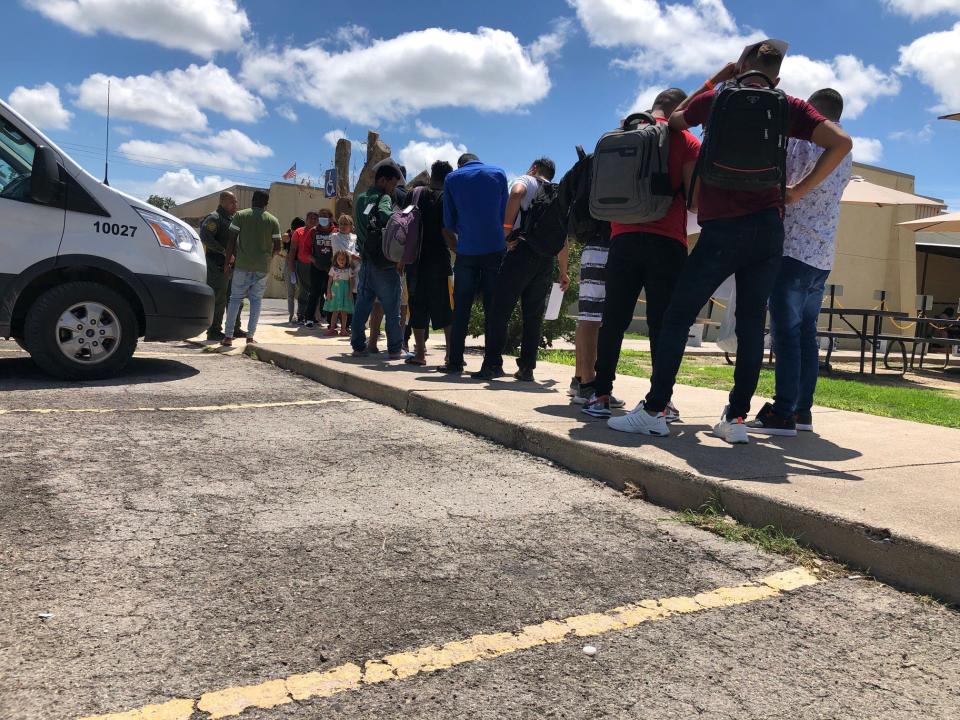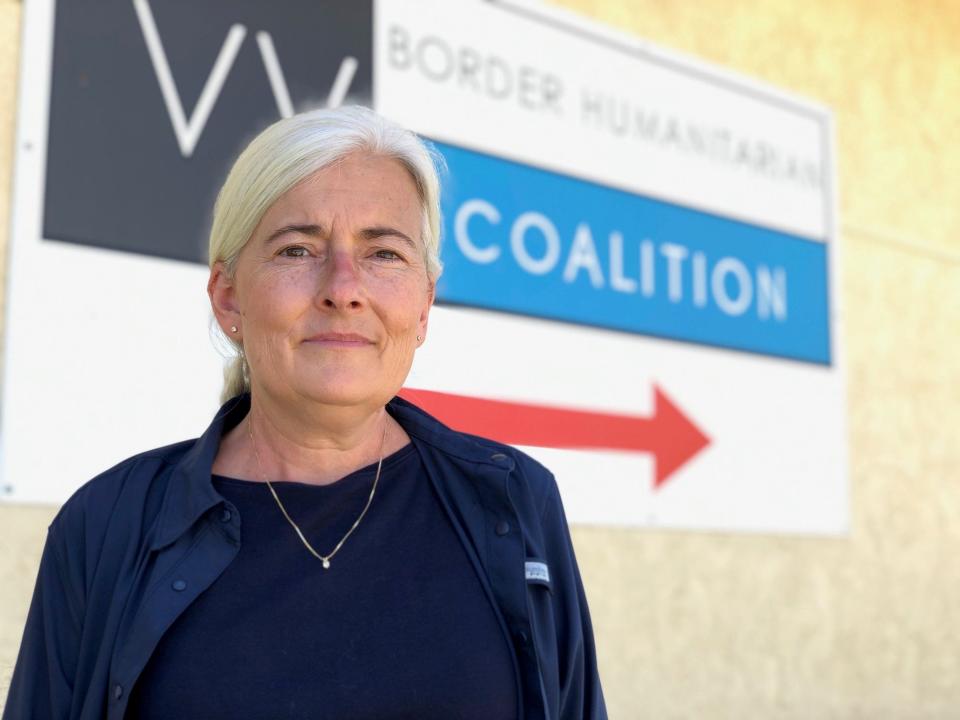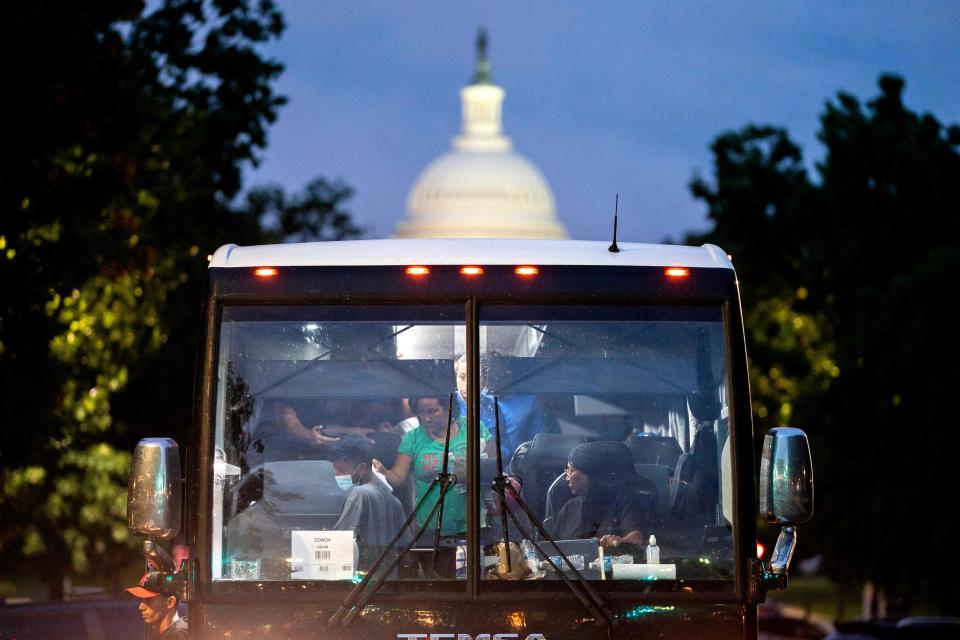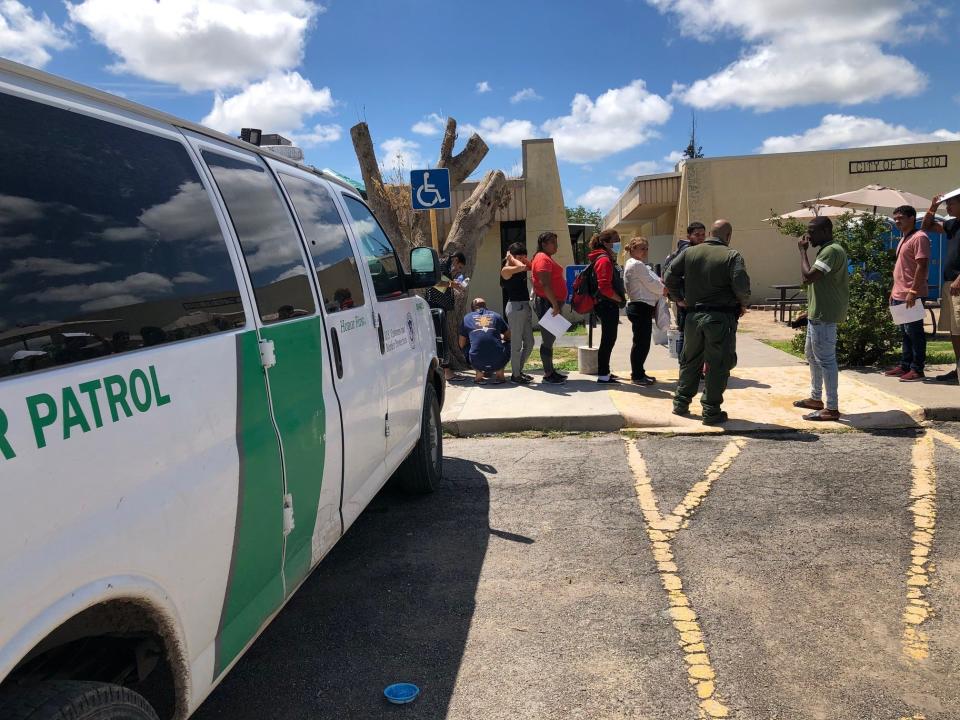Free bus rides for migrants to Washington, New York and Chicago begin in Texas border town
DEL RIO, Texas – Just past 1:30 p.m. on Tuesday, two white-and-green-striped U.S. Border Patrol vans pulled up outside the Val Verde Border Humanitarian Coalition, a migrant respite center, and 19 asylum-seekers spilled out.
Some looked dazed and were speckled with dried mud. One woman carried an infant on her hip. All looked exhausted.
Tiffany Burrow, the center’s director, greeted the migrants, chatted briefly with the Border Patrol agents, then led the migrants into the center, where they received hygiene kits and information on U.S. travel options.

Many of the migrants would board state-funded charter buses to Washington, New York City or Chicago – an initiative launched by Texas Gov. Greg Abbott earlier this year that has sparked national controversy. State officials have bused nearly 11,000 migrants to those cities.
Abbott’s office has said it is busing asylum-seekers to migrant-friendly “sanctuary cities” to protest President Joe Biden’s border policies and help alleviate the strain on Texas border cities absorbing the migrants, like Del Rio. Critics call it a political ploy that uses migrants as pawns at a cost to state taxpayers of more than $12 million.
Free bus rides: An option 'put on the table'
To Burrow, the person at the center of the unfolding drama, it’s not politics. The free bus rides are a valuable tool in easing the crush of migrants at her center. The number of migrants welcomed there has soared from 25 a week in 2019 to more than 1,100 a week today. In July, the center received 6,249 migrants -- the most since it opened.
“This is an option that was put on the table,” Burrow said of the free buses. “Why wouldn’t (migrants) take advantage of this? And just leave the politics out.”
The center opened in 2019 after Border Patrol officials contacted local leaders in Del Rio to say their holding facilities were overflowing and they needed somewhere to take the migrants after being released other than Del Rio streets. Backed by local churches and private donations, the center opened in a squat 10,000-square-foot former city public health building.

At first, Burrow, two staffers and a handful of volunteers easily handled the 25 migrants a week that were dropped off at the center, which at the time was opened just two days a week. In January 2021, as Biden took office and promised a more humane approach to border policies, the numbers spiked to 100 a week, she said.
Later that year, Del Rio made headlines when nearly 15,000 Haitians gathered in a makeshift encampment on the banks of the Rio Grande, seeking asylum in the United States. As the migrants crossed the river, Border Patrol agents on horseback tried to push them back across. Images of the mounted guards repelling the migrants splashed across TV screens and circulated through social media, sparking a furious backlash.
The number of Haitians crossing into Del Rio has declined, but the overall number of migrants using Del Rio as their crossing point is on the rise. Through July, the Del Rio sector of the U.S. Border Patrol encountered 376,136 migrants, second only to the Rio Grande Valley along the 1,933-mile U.S.-Mexico border and a 106% jump from the same time last fiscal year, according to U.S. Customs and Border Protection statistics.
Shifting smuggling routes converge on Del Rio
The large numbers of migrants, most of them from Venezuela, using Del Rio to enter the U.S. and turn themselves in to authorities point to shifting smuggling routes and migrant trends, said Adam Isacson of the Washington Office on Latin America, a research and advocacy group. With very few migrants being allowed in at the port of entry because of Title 42, the public health order that allows border agents to expel asylum-seekers to avoid the spread of the coronavirus, many turn to crossing illegally, he said.
Ciudad Acuña, Mexico, across the Rio Grande from Del Rio, is seen as safer and less in the grip of violent cartel groups compared with other Northern Mexico spots, he said. And word spreads quickly among migrants.
“Migrants are clearly being steered to these sectors,” he said. “It’s considered a safer place to cross.”
Inside the air-conditioned center, a large color map of the United States sits across from a bank of landline phones and cellphone charging stations. Burrow and her staff review the asylum-seekers' paperwork to see what destination was entered there. They also talk to the migrants to determine where they want to end up. The center does not take migrants overnight: They’re there only to clean up, grab a snack and make travel arrangements to their final destination, Burrow said.

Sometimes the Border Patrol paperwork is wrong. On Monday, Burrow spoke to a migrant who had “Alaska” written on his, although he wished to go to New York.
Travel options from Del Rio are limited: A Greyhound bus leaves twice a day – at 11:45 a.m. and again at 5:45 p.m. – to San Antonio, at a cost of $50 for a one-way ticket, and American Airlines flies twice daily from the Del Rio International Airport to Dallas. The one-way flight costs about $240. Migrants are responsible for paying their own way.
Burrow will also offer a third option: free state-funded bus rides to Washington, New York or Chicago. Only those who want to go get on the buses, she said. The majority of migrants choose the free bus rides.
“It’s completely voluntary,” Burrow said. “We don’t have a lot of options and these people don’t have a lot of money. So it’s beneficial to them.”
Stepping over bodies to reach the United States
Burrow said she has seen migrants arrive with bruises and swollen black eyes from cartel beatings. She has consoled migrants whose loved ones drowned while crossing the nearby Rio Grande and who arrive with just the clothes on their back. All are eager to reach their final U.S. destination and begin working, she said.
At the center, groups of migrants milled around outdoor picnic tables, using cellphones to call relatives to coordinate travel or figuring out how to reach their U.S. cities.
Carlos Gonzalez-Guerrero, 24, said he spent 40 days traveling with his 17-year-old brother, Vinicio, from his native Monagas, Venezuela, to the U.S.-Mexico border. They crossed through Colombia and Panama, trekking through the treacherous jungle paths of the Darién Pass, where they stepped over bodies left in the trail.
Gonzalez-Guerrero pointed to the ripped gray flannel shorts he was wearing and his soiled gray T-shirt and flip-flops. They were the only things he had left, he said.
He turned down the free bus rides because he was trying to get to his other brother in North Carolina. Instead, he was trying to scrape together the $50 for the Greyhound bus ride to San Antonio, and from there he’d try to borrow money for a flight to North Carolina.

“I’m relieved we’re here,” Gonzalez-Guerrero said. “I just want to get to North Carolina and get to work.”
Burrow said that until Congress comes up with a more permanent solution, she and the center are all these migrants have. For now, she’s focused on getting as many people on as many modes of transportation as possible so they can begin their new lives. The buses are a key part of that equation.
“It is helpful,” she said, “but I don’t anticipate this will be on the table forever.”
Follow Jervis on Twitter: @MrRJervis.
This article originally appeared on USA TODAY: Texas migrant buses start at border town before NYC, Chicago, DC stops

